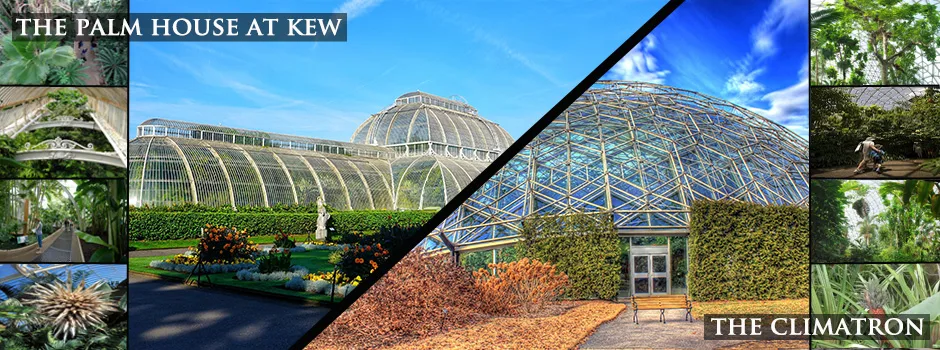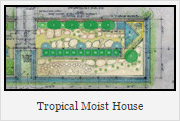
Botanical Garden Creation & Inventorying
One Community would like to make most of the benefits of amazing botanical gardens like the two pictured above accessible and replicable by the mainstream as smaller versions built and maintained by the mainstream. These privately owned and maintained botanical gardens will produce food, help preserve and regenerate our planet’s plant biodiversity, and provide beautiful places to visit, relax, and appreciate plants. We discuss this and more with the following sections:
- Why Botanical Gardens
- Ways to Contribute
- Consultants
- Biodiverse and Regenerative
- Simple to Establish and Maintain
- A Path to Strengthening the Food Web
- Individually and Economically Beneficial
- Summary
- FAQ
NOTE: THIS PAGE IS NOT CONSIDERED BY US TO BE A COMPLETE AND USABLE TUTORIAL UNTIL
WE FINISH OUR OWN CONSTRUCTION OF THIS COMPONENT, CONFIRM ALL THE DETAILS, AND ADD
TO THIS PAGE ALL THE RELATED VIDEOS, EXPERIENCE, AND OTHER UPDATES FROM THAT BUILD.
IN THE MEANTIME, YOU CAN HELP US COMPLETE IT ALL SOONER WITH THE FOLLOWING OPTIONS:
INPUT & FEEDBACK | JOIN OUR TEAM | HELP US BUY THE PROPERTY
RELATED PAGES (Click icons for complete pages)
CLICK THESE ICONS TO JOIN US THROUGH SOCIAL MEDIA
WAYS TO CONTRIBUTE TO EVOLVING THIS SUSTAINABILITY COMPONENT WITH US
SUGGESTIONS | CONSULTING | MEMBERSHIP | OTHER OPTIONS
WHY BOTANICAL GARDENS?
 In keeping with our Highest Good of All model, we consider botanical gardens to be beneficial components of sustainable teacher/demonstration communities, villages, and cities. They conserve biodiversity and foster broader access to that biodiversity, are relatively simple to establish and maintain, assist in strengthening the “food web”, and can be economically beneficial for individuals and communities. Now, like no other time in history, we have the ability to:
In keeping with our Highest Good of All model, we consider botanical gardens to be beneficial components of sustainable teacher/demonstration communities, villages, and cities. They conserve biodiversity and foster broader access to that biodiversity, are relatively simple to establish and maintain, assist in strengthening the “food web”, and can be economically beneficial for individuals and communities. Now, like no other time in history, we have the ability to:
- Access the global plant diversity
- Grow, enjoy, and share the plant diversity of the world near our homes
- Create sustainable environments for maintaining and evolving this diversity
- Globally collaborate to improve access and growing environment designs even more
As we accomplish 1-3, we will also benefit from:
- More diverse foods to eat
- More diverse non-food plant uses
- Beautiful environments to view and socialize in
- More economic opportunities related to 1, 2, and 3
WAYS TO CONTRIBUTE TO EVOLVING THIS SUSTAINABILITY COMPONENT WITH US
SUGGESTIONS | CONSULTING | MEMBERSHIP | OTHER OPTIONS
CONSULTANTS ON THIS COMPONENT OF ONE COMMUNITY
Mary Nelson: Landscape Planner
BIODIVERSE AND REGENERATIVE
 We have the ability to regenerate the Earth’s biodiversity. The worldwide rate of deforestation and loss of global plant life is staggering because some of these forests harbor the highest levels of biodiversity in the world. For example, a single tree in the Amazon basin may support dozens of species of bromeliads, orchids and other epiphytes, mosses, etc., and in turn these secondary species may be home to countless types of birds, frogs, lizards and insects. All of this disappears with the felling of a single tree and we, as conscious stewards, have the ability to begin the regenerative process right now and in our own backyards.
We have the ability to regenerate the Earth’s biodiversity. The worldwide rate of deforestation and loss of global plant life is staggering because some of these forests harbor the highest levels of biodiversity in the world. For example, a single tree in the Amazon basin may support dozens of species of bromeliads, orchids and other epiphytes, mosses, etc., and in turn these secondary species may be home to countless types of birds, frogs, lizards and insects. All of this disappears with the felling of a single tree and we, as conscious stewards, have the ability to begin the regenerative process right now and in our own backyards.
CLICK HERE FOR A 2012 PDF DOWNLOAD ON THE STATE OF THE WORLD’S FORESTS
By building self-contained food producing and recreational environments we can bring biodiversity where it normally would not be able to exist and be a part of the preservation and regenerative process. Establishing a botanical garden is the most organized and globally supportive way to do this. We are open source project-launch blueprinting the process including:
- How to acquire the plant diversity
- How to catalogue all species native to any area
- All details necessary to build and evolve biodiverse and regenerative structures starting with these two:
TROPICAL ATRIUM – Click for the Planting Plan
Central Atrium for the Earthbag Village by One Community “ Created by Gilberto Martini de Oliveira
AQUAPINIS & WALINPINIS – Click for the planting plans
SIMPLE TO ESTABLISH AND MAINTAIN
Establishing and maintaining a botanical garden is easier than most people think. Following international guidelines for botanical garden establishments, the One Community planting and propagation strategy for the entire property will include:
- Documenting all plant species indigenous to the property
- Accession of all plant material introduced to the property
- Maintaining a collections policy which conforms to the standards of the American Association of Botanical Gardens and Arboreta (AABGA) and other national and international bodies.
- Publishing an Index Seminum and distributing it to other botanical institutions to facilitate the exchange of plant material.
As part of our open source design, we will additionally publish the activities of the garden to the world at large. We will also encourage and support any and all groups seeking to replicate the One Community model to likewise incorporate this botanical garden conservation model into their infrastructure.
ACCESSION PROCESS DETAILS
The accession process is at the heart of any botanical institution. For every individual plant that is added to the gardens collection, an identification number is issued unique to that plant that follows it throughout it’s life in the collection. Along with the number, records are kept on all information known about that plant:
- It’s species (if known)
- Variety or cultivar (if applicable)
- Name of the collector (if known)
- It’s heritage, where known (if it is a hybrid)
- Location where it was collected (if from it’s natural habitat)
- Source (another botanical garden, private individual, commercial seed company etc.)
The actual mechanics of the accession process are not difficult. All that is required is a tag stamper and some metal blanks, some spreadsheet type software (BG-BASE, developed by Kew Gardens in England is the standard format), and someone to perform the data entry, record keeping, and physical tagging of plants.
The hours involved in this process are a function of the number of accessions coming into an institution at any one time. For a rapidly developing garden, or one in a phase of renewal or redevelopment, it might be a full time position to enter all the data into the accession records. More likely, it is a part-time function of a nursery manager or collection curator, perhaps 10 -20 hours per week.
ACCESSION PROCESS FROM START TO FINISH
Once this process is established, it actually only takes a few minutes per plant. Here’s an example:
 April 10, 2014: In the incoming mail is a seed packet from the University of Edinburgh Botanic Garden, containing seeds of Montanoa tomentosa RBGE #26724. The packet is taken to the Propagation area in Walapini 3 and sown in an appropriate potting mix. The seedling pot is tagged with the information: “Montanoa tomentosa- recvd 4/10/14 as seed Royal Botanic Garden Edinburgh #26724” This same information is recorded in the BG-BASE software, and a sequential accession number is generated OC #1152. This accession number is then applied for ongoing reference to the tag in the nursery pot.
April 10, 2014: In the incoming mail is a seed packet from the University of Edinburgh Botanic Garden, containing seeds of Montanoa tomentosa RBGE #26724. The packet is taken to the Propagation area in Walapini 3 and sown in an appropriate potting mix. The seedling pot is tagged with the information: “Montanoa tomentosa- recvd 4/10/14 as seed Royal Botanic Garden Edinburgh #26724” This same information is recorded in the BG-BASE software, and a sequential accession number is generated OC #1152. This accession number is then applied for ongoing reference to the tag in the nursery pot.
10 days later, seven seeds germinate and grow vigorously. This is noted in BG-BASE, perhaps a photograph is taken and entered also. When the seven seedlings are eventually potted up in individual pots, the tag stamper is used to make seven individual tags #1152-1 though #1152-7. This series of numbers is then put into the BG-BASE entry. Any further events in the life of these seven plants — death, pest predation, flowering, herbarium specimens taken, propagation, seed collection and re-distribution, etc. are recorded as they happen.
Total process time including sowing, label making, tag stamping and data entry: 5-10 minutes.
WHY ACCESSION IS IMPORTANT
Why is this important? Let’s say for example that the garden received a packet of seed for a tree from Zimbabwe sent by the Botanical Garden in Harare. The species has a natural range that covers two regions of the country. The Garden in Harare sent location data along with the seed, so that goes into the accession records. Several years later, botanists determine that the northern population of the species is actually different enough to warrant being elevated to species rank and is given a new name. Because you have the location data in your accession records, you now know to make the name change in your records.
Here’s s a true story example of why accession data is important. A plant was collected in the highlands of Chiapas and taken back to a botanical garden in California, where seedlings were grown, and each given an accession number (there was no species, as the plant had never been seen by botanists before). When the botanist returned to the area a few years later, he found that the area had been converted to farmland, and the species was gone. After searching, it was determined that the species was a narrow endemic, and that the only population of it had lived where the farm now was.
The plant was now extinct in the wild. The California garden, recognizing that they had the last living specimens, was able to collect together the different clones in the botanical garden based on the accession numbers. Using these clones, they were then able to cross pollinate and thereby express the maximum genetic diversity of this lost species. Thanks to accession and their efforts, this species was able to be recognized as the last of its kind, lives on in collections, and may one day be repopulated back to it’s native land.
A PATH TO STRENGTHENING THE FOOD WEB
The food infrastructure we are creating will strengthen the food web by adding beneficial diversity. This is good for our health and good for the food species themselves. Our early ancestors are known to have eaten over 10,000 species of plants. Today, the vast majority of the food produced in the world comes from just six species: wheat, rice, corn, soybeans, potatoes and cassava. Most of this is not consumed directly, but either processed into starch, flour, or sugar, and/or used as livestock feed. Each of these crops, and many others grown on smaller scales, have related species that are close genetic relatives with which they could potentially interbreed. This interbreeding can increase resistance to pests and diseases and help to express new and beneficial traits of the species.
ONE EXAMPLE WITH POSSIBILITY
Here’s just one example of how an organization like ours could help to strengthen the food web. Corn (Zea mays) was for many years thought to be the only member of the genus Zea. Scientists, however, discovered a weedy relative (Zea diploperennis) at the edge of a farmers field in Mexico. It only grows in a few locations covering a few square miles but this species, unlike corn, is perennial, sprouting back from the roots each year. It hybridizes with corn, and opens the possibility of breeding perennial corn, which would not need to be replanted each spring. The possibilities from this are broad and just one example of how private exploration of regenerative and biodiversity expanding practices could provide benefits for many.
ONE HISTORICAL EXAMPLE WHERE DIVERSITY WAS NEEDED
Historically, biodiversity has arguable saved our food supply more times than we can imagine. When the necessary biodiversity has not been present, like the potato famine of the 1800’s, the affects are devastating. At this time, potatoes brought to Europe from South America represented very few clones (no biodiversity) and were very susceptible to a number of fungal diseases. This was not known at the time of their introduction and by the time it became apparent, the potato had rapidly become an important staple in Europe. Especially so in Ireland, where it was nearly the sole food of 1/3rd of the population. When the blight struck, famine followed. Between 1845 and 1852, a million people died of starvation, and another million emigrated (mostly to the United States).
In this case, a lack of biodiversity of a single crop changed history. A quarter of the population of Ireland was gone and the makeup of the population of the United States was forever changed too. Similar stories can be told for crop relatives for many of the foods we eat. Conserving and regeneratively engaging biodiversity broadens the genetic base and makes plants less susceptible to outbreaks of pests and/or diseases.
The guidelines for collections of botanical gardens have, since the 1970’s, been increasingly focused on the conservation of crop relatives. It is clear that such institutions have a significant role to play in the off site conservation, preservation, and re-population of such species. We believe that through local community outreach and education, we can help conserve on-site populations as well. This is just one of many reasons that we have made botanical gardens a foundation of our for The Highest Good of All Stewardship model.
INDIVIDUALLY AND ECONOMICALLY BENEFICIAL
In recent decades, great strides have been made in our understanding of the mechanisms of nutrition and health. It has become increasingly clear that there is a strong correlation between increased amounts of phytochemicals in the diet, and better overall health. The underlying biological mechanisms of certain disease states can be directly affected by specific compounds present in the plants we eat. Expanding food diversity through natural research and means of development, while less profitable because it is not patentable, IS something we consider for The Highest Good of All and with huge individual and economic benefit for One Community and future teacher/demonstration communities, villages, and cities following our model.
 The chemical diversity in our diet began to decline about 10,000 years ago. That was the period when early humans were beginning to develop agriculture, and started the shift from a hunter-gatherer society to a settled agrarian pattern of living. As foragers, constantly on the move, we were exposed to more kinds of edible plants and a more chemically diverse diet. As settled farmers this diversity began to dwindle.
The chemical diversity in our diet began to decline about 10,000 years ago. That was the period when early humans were beginning to develop agriculture, and started the shift from a hunter-gatherer society to a settled agrarian pattern of living. As foragers, constantly on the move, we were exposed to more kinds of edible plants and a more chemically diverse diet. As settled farmers this diversity began to dwindle.
The pattern of dietary narrowing greatly accelerated in the latter half of the 20th Century as agriculture rapidly mechanized (in the wealthier countries). The decisions on what crops were grown began to focus more and more on which ones were amenable to this increasing mechanization and the human diet narrowed further. The effects of this continue to be studied as rapid increases in the rates of diseases such as cardiovascular disorders, cancer, diabetes, and others tracks to this period in our history.
We’d like to start bringing the beneficial food diversity back by organizing a mainstream movement engaging the process through botanical garden creation.
MEDICINAL VALUE
Another area of considerable importance to humanity that a botanical garden potentially addresses is the preservation and dissemination of medicinal plants. The World Health Organization estimates that 80% of the world’s population relies on plants as their sole therapeutic resource. That number is predicted to rise. Most of these medicinal plants are gathered from natural stands, and population pressures have placed many species under threat. Conservation of these species has been an important function of botanical gardens in many countries. Botanical gardens in India, for example, have worked out efficient propagation and cultivation techniques for a number of their rare medicinal plants. Disseminating this information to local farmers has improved their lives with the income generated from these new crops, while at the same time taking pressure off the wild populations.
As mentioned above, tens of thousands of species exist with a history as human food. The introduction, or reintroduction, of some of these species to people currently unaware of their existence is perhaps the oldest and simplest function of botanical gardens. Centuries ago European explorers brought back plants from many regions of the world to conservatories in Europe. Later, some of these were sent to other countries possessing suitable climates. It is thanks to this that todays global production base of cacao, pineapple, coffee, rubber and others exist. But for every species that was successfully translocated, many more didn’t survive the journey, or didn’t establish in the glasshouses of European arboreta, and were eventually largely forgotten.
We can now move plant material around the globe with a speed that would astonish early explorers. We want to teach people how and why to do this so we can lead to the introduction of many new foods, with their potential for medicinal and holistic health use, as we start awakening people to a broader nutritional base, new flavors and textures, etc. This is something we see as compelling to the mainstream publica and an important role for botanical gardens to play in the 21st Century.
ECONOMIC VALUE
 Here’s just one example of specific economic fragility that could benefit from increased species and economic diversity. In the 1920’s Henry Ford decided to produce his own rubber for the cars which bore his name. At that time, rubber, which is native to the Amazon, had been taken by the English to their colonies in Malaysia, and had a virtual monopoly on the world supply. Seeking to avoid this monopoly, Ford bought 10,000 square kilometers of land in the Amazon, cleared it, and built an entire factory town there complete with schools, hospitals and worker housing that he called “Fordlandia.”
Here’s just one example of specific economic fragility that could benefit from increased species and economic diversity. In the 1920’s Henry Ford decided to produce his own rubber for the cars which bore his name. At that time, rubber, which is native to the Amazon, had been taken by the English to their colonies in Malaysia, and had a virtual monopoly on the world supply. Seeking to avoid this monopoly, Ford bought 10,000 square kilometers of land in the Amazon, cleared it, and built an entire factory town there complete with schools, hospitals and worker housing that he called “Fordlandia.”
Something wasn’t right though. When the plantation was planted and the trees began to grow they began to be attacked by diseases and pests, and the planting failed. Ford then moved the project upriver, where it was thought the better soils would improve their chances of survival. Again the trees failed. It was finally understood that the natural habit of rubber trees is to grow widely scattered in the jungle, so that they are less prone to discovery by the diseases and pests that attack them. Eventually Ford abandoned the project.
The story, however, is not over. Malaysia is still the source of the worlds rubber supply. While synthetic rubber now dominates the market, a certain percentage of natural rubber must be incorporated into tires for optimum performance. This is especially true for aircraft tires, where the higher percentage of natural rubber helps the tires survive the high stress and impact of landing. The Malaysian plantations are possible because the pests of the tree have not yet spread to Southeast Asia. The trees there, however, are derived from a single sackful of seeds from Brazil so the appearance of such pests in the plantation could mean a rapid crash of the plantations, resulting in a severe shortage of aircraft tires in a very short time span.
This is just one example of one industry supported by a very well known plant species. In today’s information age, we have the opportunity to seek out similar industries that could benefit from support. We also have the ability to create completely new industries build on the properties and benefits of lesser known plant species. Regenerative and biodiverse planting practices supported by increased privately funded and maintained global botanical garden establishment is how we would like to help make this happen for the benefit of our planet, plants, and people.
SUMMARY
 We believe that any community can make an important contribution to biodiversity by adopting a botanical garden model. There are rare and endangered plants in every state, bioregion, and country of the world. If local communities become aware of them, and provide for their protection and propagation, many extinctions could be prevented, and the global web of life strengthened. In support of this we will be incorporating the infrastructure for a botanical garden at One Community and open source project-launch blueprinting the process to make it as easy to duplicate as possible so those interested can join us in supporting and regenerating the world’s diverse plant species for all the individual, environmental, and economic benefits a botanical garden can provide.
We believe that any community can make an important contribution to biodiversity by adopting a botanical garden model. There are rare and endangered plants in every state, bioregion, and country of the world. If local communities become aware of them, and provide for their protection and propagation, many extinctions could be prevented, and the global web of life strengthened. In support of this we will be incorporating the infrastructure for a botanical garden at One Community and open source project-launch blueprinting the process to make it as easy to duplicate as possible so those interested can join us in supporting and regenerating the world’s diverse plant species for all the individual, environmental, and economic benefits a botanical garden can provide.

FREQUENTLY ANSWERED QUESTIONS
Q: What about invasive species, how do you protect against them?
One Community and our associated Botanical Garden will abide by all applicable state and federal laws concerning the movement of plant and animal germplasm, utilizing quarantine procedures where necessary.
Q: Will you be offering plant material to others as part of One Community?
As a Member of the AABGA, we will be part of the International Convention on Biodiversity. As a Botanical institution, we will also be part of an international agreement for the free exchange of plant germplasm among scientific institutions. Scientific institutions will have priority consideration and private and commercial interests will be handled on a case by case basis and guided by our Highest Good of All principal and decision making process. We will also be partnering with providers of rare species to help support them. If you are someone who can help, please complete our short partnership application form as the first step in exploring how we can work together.
Q: Do we actually now have the ability to grow these plants from around the world virtually anywhere using indoor environments?
We believe that the open source design of the Aquapinis and Walapinis will enable virtually any species to be produced in them, opening up tremendous possibilities for the conservation of local and exotic biodiversity as part of our integrated botanical garden design
Q: What about differing soil and nutrition needs, how will these be addressed?
Soil and nutritional needs will be addressed on a plant by plant basis as they are in any commercial nursery. This process and anything learned about the specific cultural requirements of a species will be open sourced.
WHO WE ARE
MAIN OPEN SOURCE HUBS
KEY FOOD COMPONENTS
- OS Hub
- Grow
- Build
- Ethical, Humane, & Conscientious Goat Stewardship
- Ethical, Humane, & Conscientious Rabbit Stewardship
- Ethical, Humane, & Conscientious Chicken Stewardship
- Food Forest
- Hoop Houses
- Apiary/Bee Yard
- Botanical Garden Creation & Inventorying
- Conscientious Wildlife Stewardship and Habitat Development
- Large-scale Gardening
- Soil Amendment & Site Preparation
 One Community
One Community



















